What’s in Mrs. Hale’s Receipt for the Millions 1857?
- Scrape your shoes and use the mat.
Welcome to my new website. It’s been months in the making and frankly, needed a complete overhaul. So here it is. What do I hope to have for you? Better layout and accessibility. I’ll still be writing about history, my historical fiction, my love of the Pacific NW and Hawaii, and things of interest. Might have an occasional interview. I have a new spot for a newsletter which I hope to put out once a month. I thinking that I might add a give away to that. It’s all new and in a flux. Mainly, I’ll be working at writing. I have two novels in the works and after my amazing trip to Norway last fall, my sequel to The Jossing Affair is my main focus. Four novellas set in Hawaii in Kindle Worlds, are now back in my hands and in the process of being rewritten. More on that in another post.
English Encampment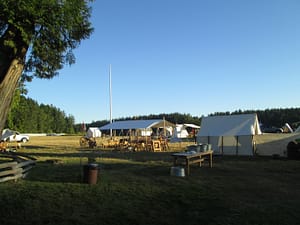
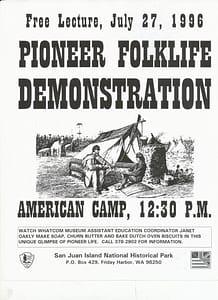
Where it all started
It’s that time of year when I gather my 1860 teaching materials and go to San Juan Island for English Encampment. I have a special place in my heart for that place. I was first introduced to the San Juan Island National Park back in the 1980s when I was invited to write a school curriculum for them. Soon I was asked to come and present a 19th century foodways program that involved a cooking demonstration as well as spinning and dyeing. It was an exciting time. I demonstrated out by the Army officer’s building at American Camp. There was a fire ban on so we had to call the fire marshal to get permission to build a fire on a metal pan. I made biscuits and churned butter. The main thing I learned that day was watch my apron. It kept flying over the fire in the wind. I did this for 21 years, going out to English Camp under the centuries-old big leaf maple trees not long after my first gig.
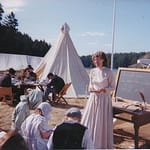 Two years later, I not only continued to do the demonstrations, but began my stint as Miss Libby, a character I had invented for the Bellingham School District’s pioneer cabin in the woods program for 3rd graders (something I loved and relished for 11 years) I was decidedly not exactly in period costume that first summer, but it was a start as Encampment was also new too. After 22 years, I’m using the same blackboard announcing Miss Libby’s Academy.
Two years later, I not only continued to do the demonstrations, but began my stint as Miss Libby, a character I had invented for the Bellingham School District’s pioneer cabin in the woods program for 3rd graders (something I loved and relished for 11 years) I was decidedly not exactly in period costume that first summer, but it was a start as Encampment was also new too. After 22 years, I’m using the same blackboard announcing Miss Libby’s Academy.
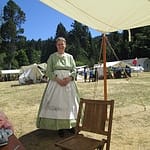 There are a lot of legends about the one room schoolhouse, but schools in Washington Territory, although rudimentary, did come under the head of the Office of Superintendent of Public Instruction like today. Books were approved for teaching and other standards put in place. Institutions by the 1870s were set up to provide training for teachers. But I digress as I often do. I just enjoy finding materials from that period to teach to modern day pupils. Like Ray’s Arithmetic. some of the problems in there I know a high schooler would have trouble with. Like converting ribbons measured with the “nails
There are a lot of legends about the one room schoolhouse, but schools in Washington Territory, although rudimentary, did come under the head of the Office of Superintendent of Public Instruction like today. Books were approved for teaching and other standards put in place. Institutions by the 1870s were set up to provide training for teachers. But I digress as I often do. I just enjoy finding materials from that period to teach to modern day pupils. Like Ray’s Arithmetic. some of the problems in there I know a high schooler would have trouble with. Like converting ribbons measured with the “nails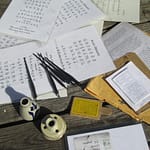 system” into yards and inches. You can read about it in my earlier blog on the Nail System.
system” into yards and inches. You can read about it in my earlier blog on the Nail System.
A Rare Group of People
In addition to teaching hands-on history enrichment to schools and colleges, I also was an museum educator for 11 years, but nothing I think compares to the wonderful people who come each year to Encampment to share their knowledge of their particular interest whether it’s Hudson’s Bay Company, period clothing and ladies’ manners, period music, US Army and the Royal Marines. We have become old friends over the years and though I don’t follow the reenactment circuit as several do, I admire the depth of their scholarship and ability to make history come alive. Last year, we had a whole family join us. It enriched the visitors who came with their children and added a lot of fun to the daily schedule we followed, beginning with the raising of the Union Jack which is allowed at English Camp. And after the park closes, there is nothing more wonderful sitting outside under the stars and telling stories.
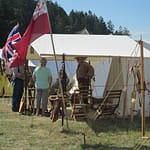
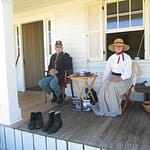
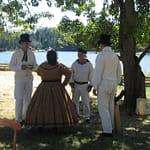

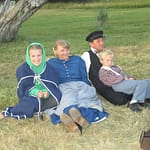 Kanakas and Coast Salish at English Camp
Kanakas and Coast Salish at English Camp
I’m a UH Manoa grad and I have been fascinated with Hawaiians in the Pacific NW for a long time. Kanakas, as they were called in the 19th century, worked at Belle Vue Farm down at American Camp. Friday Harbor was once known as Friday’s Harbor. Peter Friday, a shepherd for HBC, had his hut just above the ferry landing in today’s little village. Sailors seeing his lantern at night knew that the harbor there was safe for anchoring. Coast Salish people–Songhees and Lummi– were the indigenous people who were there centuries before the coming of the Newcomers. They were also there on the island. After years of studying, I final wrote a novel set on San Juan Island. Mist-chi-mas: A Novel of Captivity, tells the story of 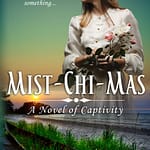 American and English Camp just after the Pig War. I finally got a chance to write about Kanakas and this incredibly vibrant time of multi-cultures and the military occupation of the island.
American and English Camp just after the Pig War. I finally got a chance to write about Kanakas and this incredibly vibrant time of multi-cultures and the military occupation of the island.
I think this is all for now. I’ve got to pack. Mahsie.
